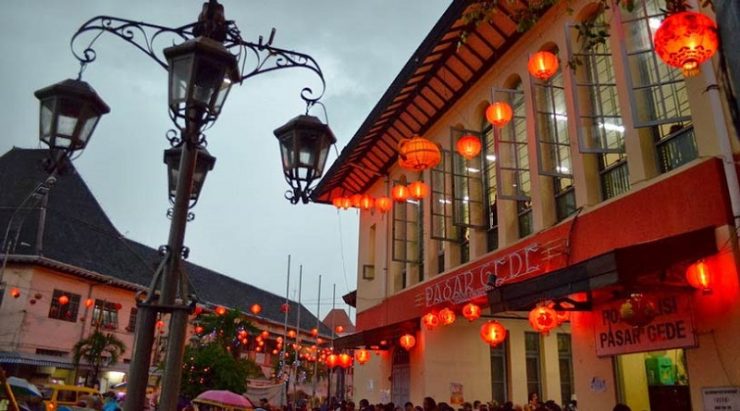GLODOK is famously known as Indonesian capital Jakarta’s Chinatown, with a history dating back 300 centuries to the Dutch colonial regime.
Glodok is home to many families of Chinese ethnicity, with a majority of them running businesses out of their dwellings — offering services or selling commodities, including many authentic Chinese dishes.
In the heart of the Chinatown lies Pancoran Street, where people have been managing family-run businesses for decades. From its “entry gate”, one can spot a dense-network of outlets and stalls hawking Chinese traditional medicine as well as food. While there are many gems hidden in the narrow alleys here, our picks will focus on the purely epicurean.
Here are the top five must-try foods to try in Glodok. Note that the culinary spots in the area mostly serve non-halal foods containing pork:
1. Akin Kuo Tie
The Chinese dimsum can be prepared several ways. Kuo tie (or guo tie) is made using the pan-frying technique, using just a smidgen of oil to bring out its crispness and add tenderness to every bite. If that’s what you crave, you can head to Akin Kuo Tieh, a kuo tie stall located at Pancoran Street VI Number 25. The alley takes some finding, but the kuo tie served at this stall will make it worth the effort.
The stall also houses a dwelling on the second floor. Thus, dine-in customers can expect very simple seating on the first floor, not to mention a taste of Jakarta’s hot weather. However, these conditions make the stall even more unique. Why the kuo tie here? It has a thick wrapper, but is balanced with a chockful of tasty filling of minced pork and chopped scallions. The skin is perfectly fried, and not too greasy.
To add more authenticity to the flavors, dip the kuo tie into the thin sauce, made from a spoonful of minced garlic, sesame oil, and black vinegar, and also sambalfor spiciness. One portion of 10 pieces of kuo tie, including the sauce, costs just IDR35,000 (US$2.5).
2. Cempedak Goreng Cik Lina
Another snack you can easily find in Pancoran Glodok is cempedak goreng, a deep fried cempedak covered in batter. Cempedak, a kind of tropical fruit, is closely related to jackfruit (nangka) and breadfruit (sukun).
Cempedak Goreng Spesial Cik Lina, a tiny stall at Pancoran 6 Number 6A offers a “live view” of its kitchen, where cempedak goreng are made fresh by order.
Customers can watch Cik Lina, who runs the stall, expertly dip ripe, sweet, and orange-ish cempedak flesh, which has been separated from its seed, into the batter, before frying it in hot oil in a wok until it turns golden brown. Served with or without brown sugar sauce, it costs a mere IDR15,000 per piece (around US$1).
3. Kopi Es Tak Kie
Gloria Alley has become one of the most famous narrow alleys in Pancoran Glodok for its food stalls. Kopi Es Tak Kie is a Chinese oldie, a legendary coffee shop located here.
While the stall has existed for three generations since 1927, it has been two generations since it began selling coffee. Kopi Es Tak Kie serves iced coffee as well as its authentic hot black coffee. Visitors can also savor some main dishes, including Chinese-style mixed rice with pork and Chinese noodles.
4. Nasi Ulam Misdjaya
Move out a little from Pancoran Street and you can taste the original flavors of Betawi’s (an ethnic group native to Jakarta) nasi ulam, rice with special soup and many side dishes.
However, the menu at Nasi Ulam Misdjaya still offers the “sensation of Chinese food” since it is located exactly in front of Toasebio, Dharma Bakti Temple, one of the oldest Chinese temples in Jakarta and not just Glodok. The Misdjaya stall has been dishing up nasi ulam for nearly 60 years. Its long history has made it legendary, while its taste and generous portions are what have made it famous.
A plate of rice with brown-ish soup — the recipe a long-held secret — with spice-boiled egg, kerupuk, and basil, which make the dish more iconic and aromatic, can be enjoyed starting from IDR20,000 (US$1.5). You can throw in other side dishes, like fried tempe or beef.
5. Pantjoran Tea House
For a cup of warm artisanal tea, served with a slice of history about the area, you can visit Pantjoran Tea House, which is located right at the “entry gate” of Pancoran Street. The building is iconic and of historical value since it used to be Apotheek Chung Hwa, established in 1928. It even served as a landmark earlier for the area built some three centuries before.
Some of the teas on the menu are served beautifully in Chinese-style pots and cups. Once here, you can even order some fancy Chinese foods, including several kinds of dimsums, rice dishes, noodles, and duck meat to satisfy your palate. [antaranews/photo special]
















